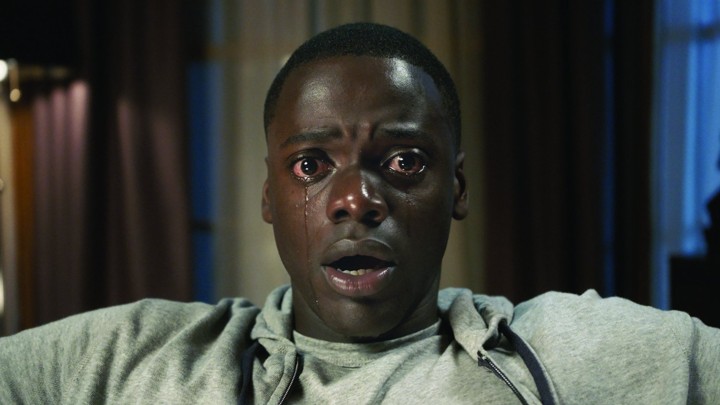The following is a guest post by Christopher Pink.
In an interview with Vulture in February of 2018, Jordan Peele, the director of Get Out, referred to his 2017 film as a “Social Thriller.” I feel the title is particularly apt for that film, as well as another entitled Society, Brian Yuzna’s 1989 directorial debut.
Get Out hardly needs an introduction; Jordan Peele walked away with a Best Original Screenplay Oscar for his directorial debut. According to IMDB, the film has won 138 other awards, and had another 190 nominations. To say that the socially-aware piece, documenting a black man’s trip to his white girlfriend’s parents’ house in upstate New York, and the oddities that ensue, is a critical darling, is an understatement.

Society is somewhat lesser known in perhaps most circles, but enjoys a fervent following in the underground. Yuzna was previously known for producing Re-Animator,another beloved underground classic and well-known entry into the exploitation canon.
For the uninitiated, which will be perhaps very few of you, the plot of Get Out follows the protagonist, Chris, as he journeys out of the city and into the country to meet his girlfriend of four months, Rose’s parents. Things begin to decline into the weird, but with a distinct and singular subtlety; Chris is surrounded by white people, each with their own brand of somewhat less-than-overt racism. Eventually, the tension moves beyond subtle racism, into some seriously dark territory, with a stock of clumsy and blunt aristocrati forming around a thinly-veiled auction, and a weird-shocker ending that you wouldn’t necessarily see coming, but that provides a perfect metaphor for certain members of society’s contemporary approach to racism. Think body snatchers.
Society’s plot opens around the time of Jenny Whitney’s debutante coming-out party. Unfortunately, or seemingly so, the protagonist of the film, Bill, won’t be able to attend because of a basketball game. While Jenny is preparing for the party, Bill finds his friend Blanchard sneaking around Jenny’s room and braces him. Blanchard tracks Bill down later at the beach, and plays him a disturbing cassette tape; apparently his sister is engaging in incest with their parents, and then moving into a full-on orgy with many of their classmates. When Bill steals the tape, and attempts to play it for his psychiatrist, the psychiatrist convinces him to let him keep the tape for the night. The contents of the tape are completely changed by the next day, leading both Bill and audience to question the veracity of what Blanchard has been saying. Disturbing reveals like this continue throughout the rest of the film, with evidence of high weirdness being introduced, and then nullified by other parties and through too-perfect explanations. This film also has a weird-shocker ending that you wouldn’t necessarily see coming, but that provides an effective metaphor for society’s approach to class. I can’t give you any hints on the ending of this one. It’s downright weird.
In bringing these two films together in this article, I hope to illustrate the similarities between them, and to highlight their effectiveness as social thrillers. One thing I found intriguing, is that both of these films use gas-lighting and paranoia as primary story telling mechanisms, and to great effect. The result is a “descent into madness” feel; as their stories march on, and through the view of the protagonist, you feel more and more claustrophobic and confined. You are very much beset on all sides, either through Get Out’s gradually increasing upper class eccentricities and antebellum hijinks, or through Society’s cracked interpretation of one-percenter high school antics.
Their perceptions bleed through into yours. Chris’s discomfort is tied directly to the feeling of being the only black man in a very white room, and Bill’s paranoia is tied to trying to parse out the actions of his classmates, parents, and psychiatrist as normal, upper-crust affairs, or as something more sinister. They each function differently, however, even through their similar mind-bending mechanisms. Society seems to prefer the “red herring” approach—introducing something insidious, and then walking it back with a mundane explanation, or using it as further evidence of Bill’s “deteriorating” mental state. Get Out, in contrast, very much operates as a slow burn. The film progresses through quickening racist microaggressions, and then eventually morphs into something more similar to Society toward its end, in spite of what you would expect from the first two acts (and perhaps from an Oscar nominated picture), with a grotesque sci-fi twist.
Before moving on from gas-lighting as a mechanism common to both films, I would like to point out both protagonists’ relationship with the psychiatrists in the films. Here are some more similarities, and some similar choices, that in turn have similar brilliant effects. While the potentially-failing mental health aspect is leaned on much more heavily in Society than in Get Out, both use psychiatrists as sort of mental anchors. Society does this in a much more overt way, with the psychiatrist himself telling Billy that he is acting crazy in response to the goings-on around him, furthering Bill’s fear and paranoia, and providing a highly effective control and inside man if, in fact, Bill’s suspicions about society are correct. In Get Out, the psychiatrist, his girlfriend’s mother, takes a more active role, not by subtly stoking Chris’s fears, but by directly hypnotizing him, an important facet of her antagonistic family’s plan.

Women also play an important role in both films, with specific women in each film being essentially the primary drivers of the plot. This effect is more pronounced in Get Out than it is in Society, but it exists and is important in both films. The woman of most importance in Get Out, is obviously Chris’s girlfriend, Rose. She serves as a lure, feigning interest in a succession of black men to draw them onto her family’s draconian estate. Similar to the psychiatrist’s role in Society, she acts as a false ally and perfect subterranean control for her family’s agenda. Society’s female of great import, Clarissa, is herself a member of society, albeit one subtly presented as a band apart from her similarly wealthy compatriots. This is done by way of her hair-eating mother, and Clarissa’s proclivity for wild sex, teacup-peeing, and general weirdness. In both films, these women serve to point the protagonist in the direction the antagonists want him to go, although Clarissa has a change of heart and turns into an ally nearer to the end of Society; the same cannot be said for Rose.
In spite of all of the aforementioned similarities between the two films, I feel there is one that stands out more so than the others, which is their endings. Both films operate for most of their entirety by building suspense, mistrust, paranoia, and a general sense of confusion and dishevelment, with both the audience and respective protagonists questioning who is friend and who is foe constantly. In both of these films, this build crescendos in a set-piece finale, where the respective primary, seemingly imagined fears are laid bare, confirming to both the protagonists and the audience that the worst case imaginable is actually real. These endings would fall flat without the accompanying builds in each film, but because care was taken on the drive up, the destination lands with force; Get Out’s with a cerebral terror and existential dread, and Society’s with a visceral, gross-out impact.
It is this distinction, between visceral and cerebral, that happens to separate the two films the most starkly. Each, of course, has differing subject matter, but I feel this particular separating point isn’t as distinct and stark as their differing approaches to story-telling using film as a medium. You could argue that the defining characteristic of an exploitation film is its use of viscera in aid of telling a story. In more traditional fare, the script, performances, set design, etc., all have to be done well to carry a story off. In exploitation cinema, this is no different, but because of a visual focus, whether that be gross-out effects, graphic violence, gratuitous language, liberal sexual depictions, and on and on, that exists in exploitation film, the visual aspect of a film becomes incredibly important. I’m not going to lie; Get Out has a much better script than Society. The performances are more solid, the dialogue is better, and the lighting, cinematography, and set design are more masterfully done. The overall presentation is slicker, and perhaps the story is more compelling to most audiences, but Society holds a special place in cult fans’ hearts. Cinema verité it is not, but Society utilizes its visual medium to gross excess, and is the gem it is for it. Shape shifting women, hair-eating quadragenarians, writhing gooey masses. A man holding a dog catcher’s leash with a hand for a head. The visual artifacts tell the story in just as effective a way, not in a way that requires deep thought, but in a way that directly projects its ambitions using the camera itself.